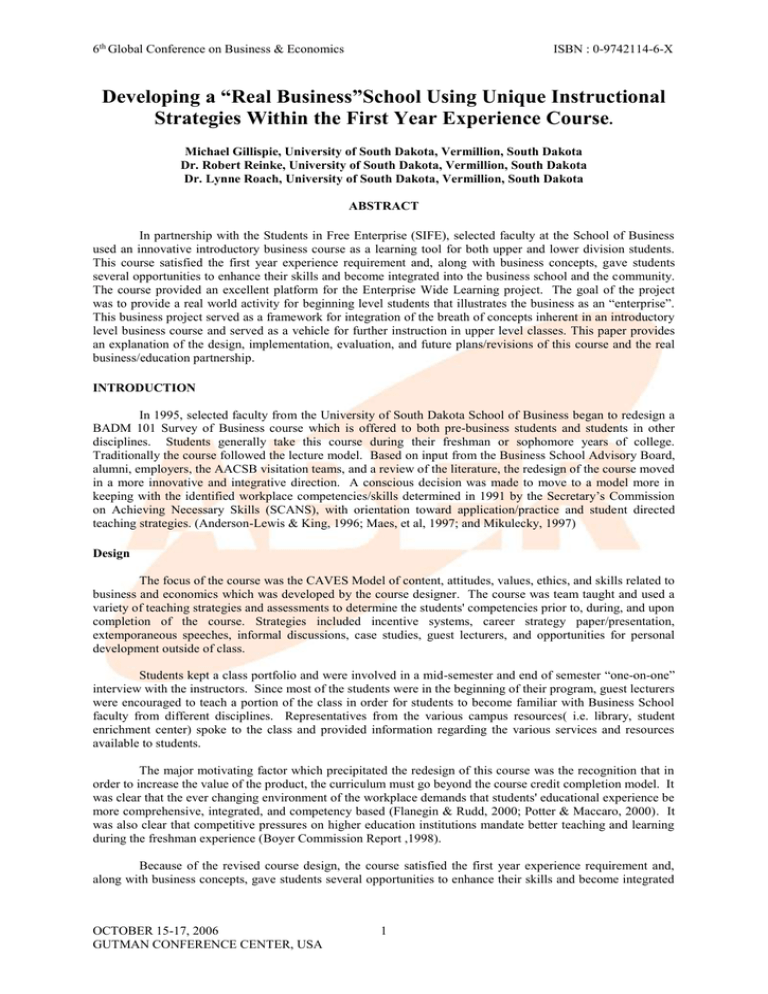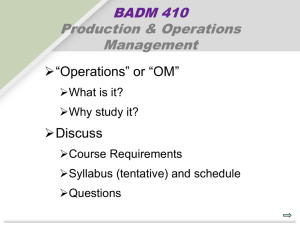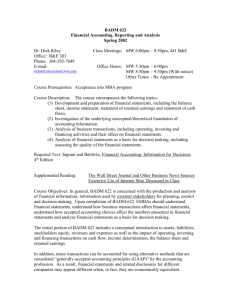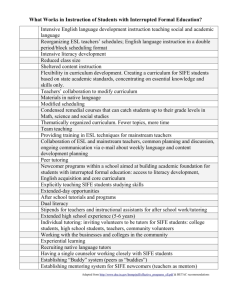Developing a “Real Business”School Using Unique Instructional Strategies Within the First Year Experience Course.
advertisement

6th Global Conference on Business & Economics ISBN : 0-9742114-6-X Developing a “Real Business”School Using Unique Instructional Strategies Within the First Year Experience Course. Michael Gillispie, University of South Dakota, Vermillion, South Dakota Dr. Robert Reinke, University of South Dakota, Vermillion, South Dakota Dr. Lynne Roach, University of South Dakota, Vermillion, South Dakota ABSTRACT In partnership with the Students in Free Enterprise (SIFE), selected faculty at the School of Business used an innovative introductory business course as a learning tool for both upper and lower division students. This course satisfied the first year experience requirement and, along with business concepts, gave students several opportunities to enhance their skills and become integrated into the business school and the community. The course provided an excellent platform for the Enterprise Wide Learning project. The goal of the project was to provide a real world activity for beginning level students that illustrates the business as an “enterprise”. This business project served as a framework for integration of the breath of concepts inherent in an introductory level business course and served as a vehicle for further instruction in upper level classes. This paper provides an explanation of the design, implementation, evaluation, and future plans/revisions of this course and the real business/education partnership. INTRODUCTION In 1995, selected faculty from the University of South Dakota School of Business began to redesign a BADM 101 Survey of Business course which is offered to both pre-business students and students in other disciplines. Students generally take this course during their freshman or sophomore years of college. Traditionally the course followed the lecture model. Based on input from the Business School Advisory Board, alumni, employers, the AACSB visitation teams, and a review of the literature, the redesign of the course moved in a more innovative and integrative direction. A conscious decision was made to move to a model more in keeping with the identified workplace competencies/skills determined in 1991 by the Secretary’s Commission on Achieving Necessary Skills (SCANS), with orientation toward application/practice and student directed teaching strategies. (Anderson-Lewis & King, 1996; Maes, et al, 1997; and Mikulecky, 1997) Design The focus of the course was the CAVES Model of content, attitudes, values, ethics, and skills related to business and economics which was developed by the course designer. The course was team taught and used a variety of teaching strategies and assessments to determine the students' competencies prior to, during, and upon completion of the course. Strategies included incentive systems, career strategy paper/presentation, extemporaneous speeches, informal discussions, case studies, guest lecturers, and opportunities for personal development outside of class. Students kept a class portfolio and were involved in a mid-semester and end of semester “one-on-one” interview with the instructors. Since most of the students were in the beginning of their program, guest lecturers were encouraged to teach a portion of the class in order for students to become familiar with Business School faculty from different disciplines. Representatives from the various campus resources( i.e. library, student enrichment center) spoke to the class and provided information regarding the various services and resources available to students. The major motivating factor which precipitated the redesign of this course was the recognition that in order to increase the value of the product, the curriculum must go beyond the course credit completion model. It was clear that the ever changing environment of the workplace demands that students' educational experience be more comprehensive, integrated, and competency based (Flanegin & Rudd, 2000; Potter & Maccaro, 2000). It was also clear that competitive pressures on higher education institutions mandate better teaching and learning during the freshman experience (Boyer Commission Report ,1998). Because of the revised course design, the course satisfied the first year experience requirement and, along with business concepts, gave students several opportunities to enhance their skills and become integrated OCTOBER 15-17, 2006 GUTMAN CONFERENCE CENTER, USA 1 6th Global Conference on Business & Economics ISBN : 0-9742114-6-X into the business school and the community. Simply put, the course design took away the “I can’t” and only left students with “I won’t” in regards to college level work. Each teaching strategy and student activity provided students the opportunity to expand their level of participation and thereby increase their level of knowledge transfer as set out by Bloom and his colleagues (1956). Moreover, using a contemporary view of competency based education, students also had opportunities to develop competencies and skills in four basic areas as set out by Evers, et al (1998): Managing Self; Communicating; Managing People and Tasks; and, Mobilizing Innovation and Change. Formative evaluation of the course took place each semester with input from faculty, students and members of the business community. This input, along with the research concerning first year experience (Cohen, 2000; Lifton, et al, 2000; Bobrowski, et al 2004), integrated business curriculum (Flanegin & Rudd, 2000; LeMaster, et al, 2000; Potter & Maccaro, 2000; Carmichael & Caldwell, 2002; Strempek, et al, 2004; Atchison, et al, 2005), and retention (Lifton, et al, 2004), has resulted in changes to the original redesigned curriculum and supports the view of continuous improvement or “always a work in progress.” By Fall of 2005, these changes included pre/post surveys regarding content and perceptions of skills/attitudes, mentorship, use of integrated business systems, involvement of the business community, addition of electronic portfolios, and request that the course be required of all business school students. The course also provided an excellent platform for the Real Business Project (EWL, Inc.). The goal of the project was to provide a real world activity for beginning level students that illustrates the business as an “enterprise”. This business/education partnership served as a framework for enhanced integration of the breath of concepts inherent in an introductory level business course. Implementation Due to the curriculum changes and resource constraints, modification of BADM 101 was made to change from a team taught format to single instructors working cooperatively with a BADM 101 coordinator and the team. Each section faculty member was a volunteer (with workload credit) and each represented a different discipline. During the pilot phase, a common BADM 101 core curriculum was created to assist the faculty. This package included faculty involvement and training, plus lesson plans and instructional material. The curriculum package also contained the connection with the Real Business Project. The Real Business Project was designed to re-focus the School’s business curriculum. Previously, the majority of the courses offered to undergraduate and graduate students pursuing management/administration degrees were discipline focused and began the sophomore year. The School’s classes were state of the art from a discipline perspective, but faculty felt they could be made more effective by becoming more interdisciplinary, applied, and connected to a business all of the students work for, own, and understand at the highest level of detail. By managing the business using the industry leading Enterprise Resource Planning systems (ERP), a learning environment was created where students made decisions by seeing how businesses view themselves through technology generated reports; why comprehensive data is necessary to make fast, high quality interdisciplinary decisions; and how needed change is optimized. Creating within the School a real ongoing business with the potential to be directly and indirectly connected to any or all of the required and elective courses, improves the curriculum by offering students and faculty alike a local living case study where real choices are made and their related consequences experienced. Given the nature of the preliminary activities for business creation, a number of selected courses were employed as resources for the “Start-Up” planning and administration. Legal structures, business plans, and financial relationships emanated from upper level courses. Once in operation, a more formal curriculum focus took place beginning at the freshman experience level. As the freshman level is the starting point for the more formal curriculum development to begin, decisions were made to modify BADM 101 Survey of Business to “open the door” to the EWL, Inc. real business. The Students in Free Enterprise (SIFE) students, along with the Business School, formed a real 501(c)3 business, EWL, Inc. and the students in BADM 101 were EWL, Inc. employees. In the beginning two businesses were started. One business involved designing and selling University logo items to promote the university and the second involved printing and selling of innovative class schedules. SIFE members served as executive managers and coordinated the business activities with faculty who integrated them into their courses. Faculty used the business activities as “living case studies” and students in those classes received course assignments tied to the business activities. BADM 101 students gained valuable hands-on experience and were OCTOBER 15-17, 2006 GUTMAN CONFERENCE CENTER, USA 2 6th Global Conference on Business & Economics ISBN : 0-9742114-6-X able to make a connection between the theories introduced in class and the application of those theories. More often than not, it helped students decide if a business career was truly the career path they wanted. The SIFE business project was run using “best practices” of real business planning and execution. Input from faculty, administration, and private sector partners were an important part of this SIFE Real Business effort. For example, EWL, Inc. has a Board of Directors and the students produce an annual report and other valuable information. Each of the two businesses that were formed the first year was supported by a primary faculty advisor. The project has become an ongoing part of the SIFE program and will connect to the BADM 101 course every semester. SIFE members were trained and used an acceptable ERP system for operating their business unit. They then integrated BADM 101 students into the systems operation. Finally, SIFE was provided with a “business space” within the school and BADM 101 students who wished to continue working in the SIFE “Real Business” after completion of the course could join SIFE. A 1-3 credit generating opportunity was made available for the SIFE middle managers. Evaluation Evaluation of the BADM 101 Survey of Business took place in several areas. Pre/Post surveys were administered to determine students’ perceptions of their skills in various areas. The composite results of the thirty-eight (38) self evaluation items showed fourteen (14) items had a significant positive change at the .01 level of significance and nine (9) items posted positive change at the .05 level of significance. Using university records, research was conducted focusing on student retention rates (Fall 03-79%; Fall 04-85%) and in-major retention (Fall 03-80%; Fall 04-76 %). The nationwide retention rate is 73.6% (Education Commission of the States, 2005), the statewide retention rate for South Dakota is 69.7%(NCHEMS Information Center,2002), and the University retention rate is 63%. At the end of the course, students completed an overall course evaluation, including the EWL, Inc. project. Students were asked to evaluate their overall satisfaction, experience and impression of the EWL project. On a scale from 1(low) to 7(high), over half (68%) of students rated their overall experience 4 or higher. Rating specific EWL/SIFE experiences on a scale of 1(strongly disagree) to 5(strongly agree), students agreed/strongly agreed that they received adequate direction (53%); that opportunities were provided to ask questions (71%); that the project was relevant to course content (58%) and a good source for practical application (53%); that process for job selection/assignment was efficient and fair (58%); and, that it is fair for students to accept responsibility for execution of the EWL project (61%). Weekly meetings of the teaching team were held for formative evaluation and adjustment of course strategies. Collectively, the information spots challenges early and helps faculty make changes when needed. Due to the unique structure of the course and the number of evaluation instruments, only information pertinent to this discussion has been extrapolated. Copies of all instruments and more detailed data analysis can be obtained by contacting lroach@usd.edu. Future Plans/Revisions Future plans for the real business/education partnership include: Graduates of BADM 101 will be assigned an electronic portfolio obligation that will require students to add designated items/experiences to their portfolio over the remaining three years. A number of these ongoing assignments will foster a more integrated business perspective. A completed portfolio will be included in the request for graduation. The existing pre-business structural core will remain in tact with a voluntary integration revision being asked of all faculty members teaching these courses. This revision will be supported with a center having updated integrated instructional resources, private sector speakers bureau, workshop experiences, and new insights emanating from the experiences of the multi-discipline BADM 101 teams. An enhanced capstone experience will be integrated into the Business Policy and Strategy Course (perhaps renamed Strategic Planning). It is proposed that this course be provided at the end of the students’ junior year and an additional three credit hour course be added that will “house” an extreme business simulation activity that will once again reinforce integration. OCTOBER 15-17, 2006 GUTMAN CONFERENCE CENTER, USA 3 6th Global Conference on Business & Economics ISBN : 0-9742114-6-X A required exit exam of all business school students will be added to the program with a passing score required for graduation. Students can take the exam as many times as necessary, but a designated passing score must be earned before the degree is conferred. Graduate students could be integrated into the SIFE business experience as consultants, problem solvers, or upper management personnel. This would be a “natural” progression as some of our graduate students will eventually have experience in the complete proposed integration effort. Anticipated Outcomes Several outcomes are anticipated as a result of this real business/education partnership. outcomes include: These Improved retention rates. Improved matriculation rates to the Business School programs. Elevated student success possibilities. Introduction of critical thinking. Placement of students into a career exploration mode early. Improved ability of graduates to “hit the ground running” on their first job after graduation. Creation of a model for first year success courses. Creation of a University culture that places higher quality and quantity resources earlier in a student’s experience. Fulfillment of all aspects of a First Year Experience. Reflections A few things need to be said about the attitude and process of “seeking a better way every day” regarding business education. In our situation, many things of substance were gained from re-engineering our curriculum using a student (learner) centered model: Greater respect among faculty Acceptance of the professor as a coach rather than a fountain of knowledge Realization that quality instructional effort is a team effort and requires additional resources Establishment of an open-door policy to members of the community Demonstration that instructional practices and decisions are very important and work in this area creates fertile ground for research This experience suggests that reworking curriculum by reflecting on what researchers, business people, students, and faculty have to contribute pays huge dividends. Often the benefits go far beyond the creation of a revised course. The outcomes can, in fact, be a new and more productive culture for all. REFERENCES Anderson-Lewis, L. & King, T.C. (1996). Improving interpersonal skills through cooperative learning. (ERIC Document Reproduction Service No. ED406524). Atchison, M.D., Hamilton, L.A., Kehoe, W.J., & Zeithaml, C.P. (2005). Integrated Core Experience (ICE): Concept, Planning, Implementation and Outcomes. Journal of the Academy of Business Education, 6, 80. Bloom. B. S. (Ed). (l956). Taxonomy of educational objectives: Classification of educational goals. Handbook 1: Cognitive domain. New York: Longman, Green & Co. Bobrowski, P.E., Carroll, J.M.,Cox, P.L.,& Jalife, P. (2004). Gateway to business: An innovative perspective on integrating technology skills in the freshman year. Journal of Management Education, 28(l), 62-87. Boyer Commission Report on Educating Undergraduates in the Research University, Reinventing Undergraduate Education: A Blueprint for America's Research Universities, published 1998, 19. Carmichael, D.B. & Caldwell, J.S. (2002). Developing interpersonal skills for business success. Academy of Business Education Proceedings, http://www.abe.villanova.edu/proc2002/carmichael.pdf (Accessed July 28, 2006) Cohen, A. (2000). Adapting a first year student success course to the business school environment. Proceedings of the American Society of Business and Behavioral Sciences,Vol.7(3), 36-40 OCTOBER 15-17, 2006 GUTMAN CONFERENCE CENTER, USA 4 6th Global Conference on Business & Economics ISBN : 0-9742114-6-X Education Commission of the States (2005), Education Policy Issue Site, Retention http://www.ecs.org/html/IssueSection.asp?issueid=182&s=Quick+Facts (Accessed July 28, 2006) Evers, F. T., Rush, J.C. & Berdrow, I. (1998). The Bases of Competence. San Francisco: Jossey-Bass Publishers. Flanegin, F.R. & Rudd, D. (2000), Integrating Communication Skills And Business Education: Teaching for Tomorrow, Academy of Business Education, Proceedings, http://www.abe.villanova.edu/proc2000/n045.pdf (Accessed July 28, 2006) LeMaster, J., Davis, R., & Schlais, D. (2000), Early Integration of the Functional Areas of Business: Using a simulation-based approach to teaching introduction to business. Proceedings of the American Society of Business and Behavioral Sciences, Vol.7(8), 74-82. Lifton, D.E., Cohen, A.& Schlesinger, W. (2000). Retaining undergraduate business students: A new approach to the crucial first semester. Academy of Business Education, Proceedings http://www.abe.villanova.edu/proc2000/n104.pdf Lifton, D. and Cohen, A. & Schlesinger, W. (2004) Improving In-Major Retention and Grade Point Average Through First-Year Curricula Linkage: Results from a Business School Longitudinal Study", Journal of the Academy of Business Education, 5, 21-27. Maes, J. D., Weldy, T. G. & Icenogle, M.L. (1997). A managerial perspective: Oral communication competency is the most important for business students in the workplace. The Journal of Business Communication, 34(1), 67-81. Mikulecky, L. (1997). Chelsea Bank: SCANS and workplace knowledge. (ERIC Document Reproduction Service No. ED 410237). NCHEMS Information Center (2002), Completion: Retention Rates, http://www.higheredinfo.org (Accessed July 28, 2006) Potter,M.& Maccaro,K.(2000). The business of teaching business. Academy of Business Education, Proceedings, http://www.abe.villanova.edu/proc2000/n034.pdf (Accessed July 28, 2006) Strempek, R. B., Burbridge, J. J., & Paul, K. E. (2004). Taking Student Engagement in Business to the Next Level: The Enterprise Academy. Journal of the Academy of Business Education, 5(Spring). U S Department of Labor (1991). What work requires of schools—A SCANS report for America 2000. Secretary’s Commission on Achieving Necessary Skills, Washington, DC: U S Department of Labor. OCTOBER 15-17, 2006 GUTMAN CONFERENCE CENTER, USA 5


